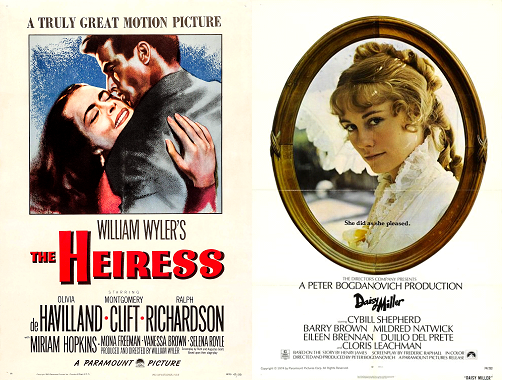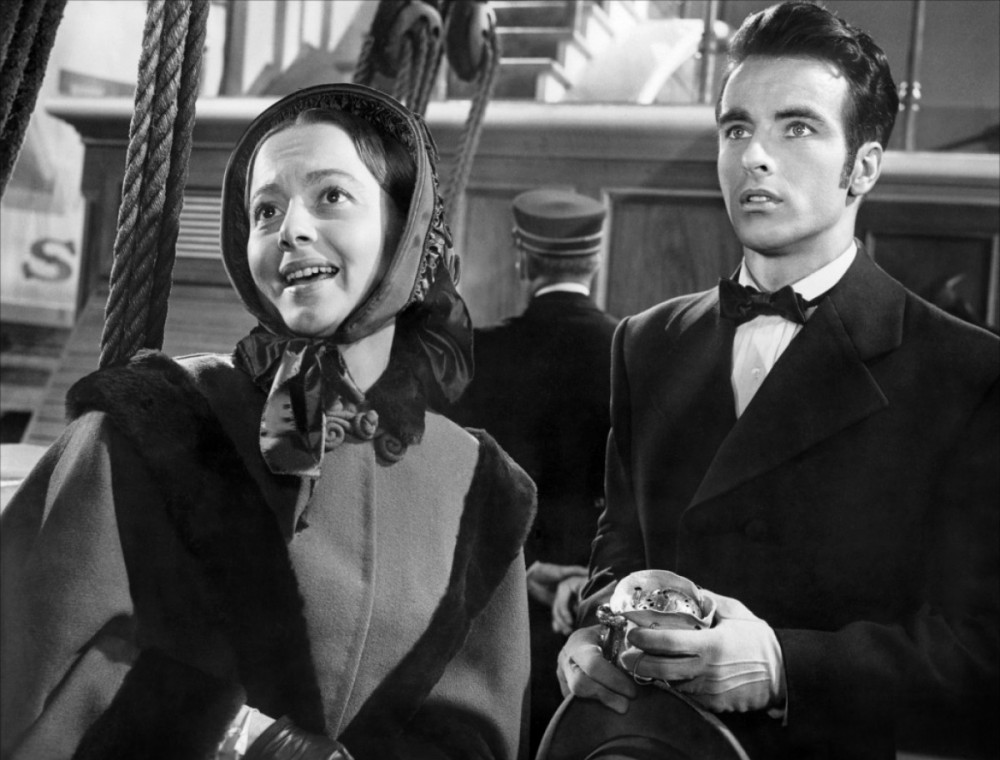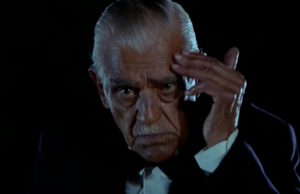The Heiress (1949) and Daisy Miller (1974)

Toronto Film Society presented The Heiress (1949) on Monday, December 7, 1981 in a double bill with Daisy Miller (1974) as part of the Season 34 Monday Evening Film Buffs Series “B”, Programme 5.
The Heiress (1949)
Production Company: Paramount. Producer: William Wyler. Director: William Wyler. Screenplay: Ruth and Augustus Goetz, based on their play The Heiress, suggested by the novel Washington Square by Henry James. Art Director: John Meehan. Music: Aaron Copland. Photography: Leo Tover. Editor: Wlliam Hornbeck. Song by Ray Evans and Jay Livingston, “My Love Loves Me.”
Cast: Olivia De Havilland (Catherine Sloper), Montgomery Clift (Morris Townsend), Ralph Richardson (Dr. Austin Sloper), Miriam Hopkins (Lavina Penniman), Vanessa Brown (Maria), Mona Freeman (Marian Almond), Ray Collins (Jefferson Almond), Betty Linely (Mrs. Montgomery), Selena Royle (Elizabeth Almond), Paul Lees (Arthur Townsend), Harry Antrim (Mr. Abeel), Russ Consway (Quintus), David Thursby (Geier).
Daisy Miller (1974)
Production Company: Copa De Oro, for Paramount, A Directors’ Company Presentation. Producer: Peter Bogdanovich. Director: Peter Bogdanovich. Screenplay: Frederic Raphael, based on the story by Henry James. Photography: Alberto Spagnoli. Editor: Verna Fields. Art Director: Ferdinando Scarfiotti. Music: excerpts from the works of J.S. Bach, W.A. Mozart, Johann Strauss, Boccherini, Haydn, Schubert, Verdi.
Cast: Cybill Shepherd (Daisy Miller), Barry Brown (Frederick Winterbourne), Cloris Leachman (Mrs. Ezra B. Miller), Mildred Natwick (Mrs. Costello), Eileen Brennan (Mrs. Walker), Duilio Del Prete (Mr. Giovanelli), James McMurtry (Randolph Miller), Nicholas Jones (Charles), George Morfogen (Eugenio).
One misses his voice badly. It is as much a
character in his work as Forster’s is in his.
If it is so impossible in a film or play to
reproduce the aery mesh of Jame’s view of the
lonely and unknowing multitudes of this world
–and it seems from the record that it is–
then why try?
-Penelope Gilliatt, New Yorker, May 27, 1974
(Review of Daisy Miller)

As a novelist, Henry James insisted upon “the solidity of specification,” compared the task of the novelist to that of the historian, and argued, like his younger colleague Joseph Conrad, that the purpose of the novel is to make us see. Nevertheless, the internality of James’s narratives (Conrad called him “the historian of fine consciences”) is such as to make his translation to film extremely difficult. While, as Cecil B. DeMille said, D.W. Griffith “taught us how to photograph thought,” it was not until the film itself began to explore symbolically the internal world of its characters that it was seriously possible to translate James directly to film. Thus a number of major directors of the past thirty years who in their greater concern with the inner consciousness over the surfaces of reality are cinematic analogues to James the novelist: Antonioni (whom Richard Roud twenty years ago called the Henry James of film), the later Fellini, Resnais, Joseph Losey. None of these directors, unfortunately, has yet tried to adapt James.
Before 1950, the most successful adaptations of James were based not directly on his novels, but on already dramatized versions of them: Frank Lloyd’s Berkeley Square (1933), at two removes from the unfinished novel The Sense of the Past (1917); and William Wyler’s The Heiress (1949), at two removes from the early Washington Square (1881). Berkeley Square, however, for all its popularity as a costume piece, for all Leslie Howard’s performance, has next to nothing to do with a novel in which James working towards a last endlessly nuanced definition of Anglo-American relations, at a time when he finally gave up his own American citizenship; the remake, I’ll Never Forgeet You (1951), with Tyrone Power, underlines the vulgarization of the Jamesian subtlety.
After 1950, three films in particular stand out, all made in the last decade: Truffault’s The Green Room (1978), based on two nouvelles of his maturity; James Ivory’s The Europeans (1979), based on his third novel (1878); and Peter Bogdanovich’s Daisy Miller (1974), based on his long tale of 1878.
Truffaut’s task was clearly the hardest; and he produced what must now stand as the perfect visual paradigm for Jamesian point-of-view–the image of the director himself shot through a scalloped glass door, which distorts his appearance as he hides from and observes the heroine of the story.
Bogdanovich’s task was easier, because of both the relative lack of ambiguity in Daisy Miller, and its more external quality. He clearly had a good deal of assistance from his scriptwriter, Frederic Raphael, who had won an Academy Award for an earlier treatment of innocence-in-decadence, John Schlesinger’s Darling (1965), had explored the theme further in his version of Iris Murdoch’s A Severed Head (1971), making along the way an excellent novel-into-film translation of Hardy’s Far From the Madding Crowd (1967–also for Schlesinger).
Wyler’s task was the easiest of the three, with a highly successful Broadway script to hand, and the Jamesian subtleties already removed. Washington Square (the title places and classifies the heroine, rather than merely centralizing her) broaches a familiar theme for James: the unlived life, unlived by choice as much as by circumstance. His Catherine is dominated by her father, as a scapegoat for the earlier death of her mother; when Morris appears on the scene, the father sees him as both fortune-hunter and rival, while Catherine sees him as both someone to be helped by her inheritance and someone to be loved and to love (It is a measure of the Jamesian subtlety that these different views are the same; though James reserves Morris’s own ambiguity as a futher turn of his screw). Catherine refuses to promise her father that she will never marry Morris after his death, though she too has grown to see him–it is still not absolutely clear that he is, though he has jilted her–as a fortune-hunter. For motives not likely in their complexity to commend themselves to a matinee audience, she renounces him at the end: “she had lived on something that was connected with him, and she had consumed it in doing so.”
With the matinee audience in mind, the playwrights, who became the screenwriters, simplified the motives of all James’s characters–the title reduces Catherine to a simpler dimension; the highly indirect presentment of a psychopathological relation between the father and the daughter disappears; Morris is more unequivocally after the heiress’s money; and the end is sentimentalized, not least by Morris’s full comeuppance (in the novel he accetps his dismissal). The simplification of motives, however, is counteracted to some extent by the actors–less their performances, superb as at least four of these are, than their iconic qualities as actors. The downplaying of the father-daughter relation is balanced by what Olivia De Havilland brought wit her from The Snake Pit, and audiences were attuned to her as a figure of renunciation from To Each His Own. Ralph Richardson’s mannered fussiness and bluster reinforce the sense of something odd about his dominance of his daughter; he had also just played the oppressive Karenin in Duvivier’s Anna Karenina, and the ambiguously perverse father-figure of The Fallen Idol, written by a great admirer of James, Graham Greene. Montgomery Clift’s brooding ambivalence (etched on his face as well as in his recent performance in Red River) give back a complex dimension to Morris. And Miriam Hopkins, as the Jamesian go-between of doubtful morality, was returning to the screen after an absence not long enough for audiences to have forgotten her many devious roles, especially opposite Bette Davis.

Bogdanovich brought no icons to making of Daisy Miller, though by 1974 (this was his fifth fiction film) he had gathered around him, like most creative directors, a regular troupe of workers. The casting of Cybill Shepherd as Daisy provoked a reaction as adverse as Daisy had done a century before, when one critic had called her “an outrage on American girlhood.” In truth, Shepherd is the perfect visual equivalent of the “common,” “uncultivated” Daisy–“in her light, sweet, superficial little visage there was no mockery, no irony.” Even her Texas twang works better in 1974 than a Schenectady sound, which was James’s reductio ad absurdum of provincialism for his day. And her ineptitudes as an actress happily convey the essential gaucherie and brashness of the character.
The nearest thing to an icon in Daisy Miller may be Mildred Natwick, who had played amiably dotty New England patricians in The Late George Apley an The Trouble with Harry. Here she plays the most formidable of Jamesian women, the American grande dame abroad. That versatile actress Eileen Brennan plays here another of those indefinably vampirish Americans abroad that James regarded as worse than decadent Europeans. And Cloris Leachman expertly carries over her own brand of slightly scatty vulgarity as Daisy’s mother.
The one weak acting performance in the film is Barry Brown’s as Winterbourne. This character broods over the novel, and the story is ultimately as much about his masucline falure as about daisy’s feminine overreachment. While the camera coincides with his eyes at moments (the early high-angle shot as Daisy and Giovanelli walk in the courtyard, under Winterbourne’s censoring observation), the same camera alienates us from the figure who is supposed to be our guide. James’s Winterbourne ought to look like the young Dirk Bogarde with some of the experience of playing Aschenbach; this Winterbourne looks like a youthful American of the 1960s bumming across Europe on $1000 a day.
But both these versions return us to Penelope Gilliatt’s question. One does miss his voice badly. A novelist like Dickens, his art already so visual, transfers splendidly film. A novelist like James peering into psychic abysses, does not. The mitigated success of these two films we owe to their being based on novels where more is to be seen by the eye, and the abysses are less deep than usual.
Notes by Barrie Hayne










Leave a Reply